The warmth of the summer sun encourages folks outdoors to play in the water, enjoy the longer evenings, and bask on the patio in the garden. So, choosing a variety of summer flowering vines might be the perfect way to add that extra bit of beauty and pleasure to your home.
Many keep their blooms all summer long, offering shades of red, pink, white, yellow, orange, and purple to their admirers. Consider which might do well as container plants for your patio or are best suited to a larger garden space.
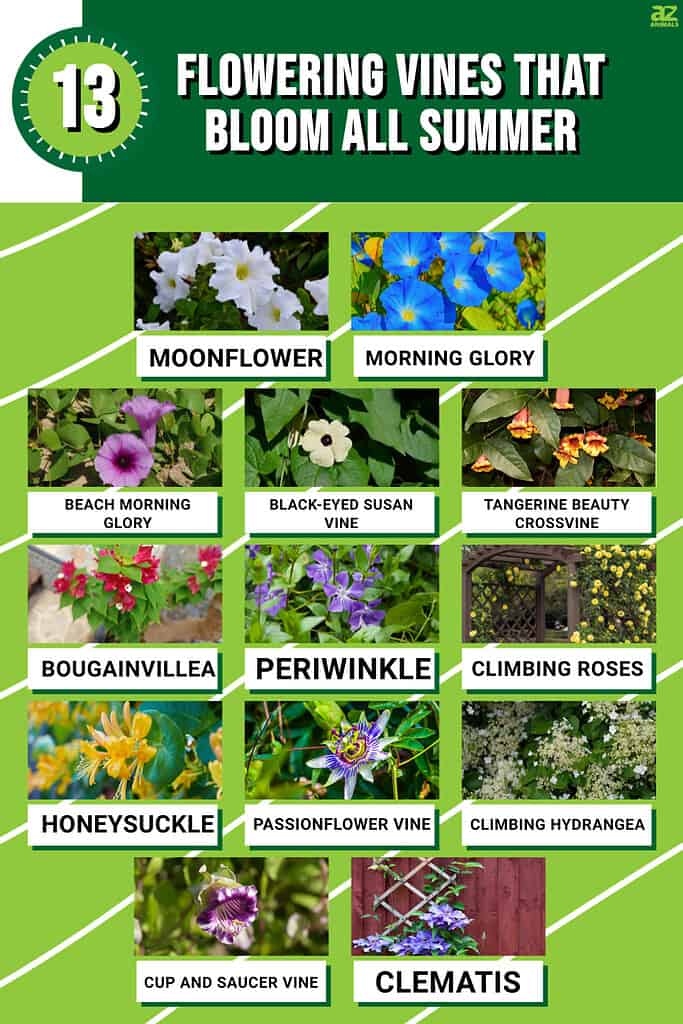
Moonflower (Ipomoea alba)
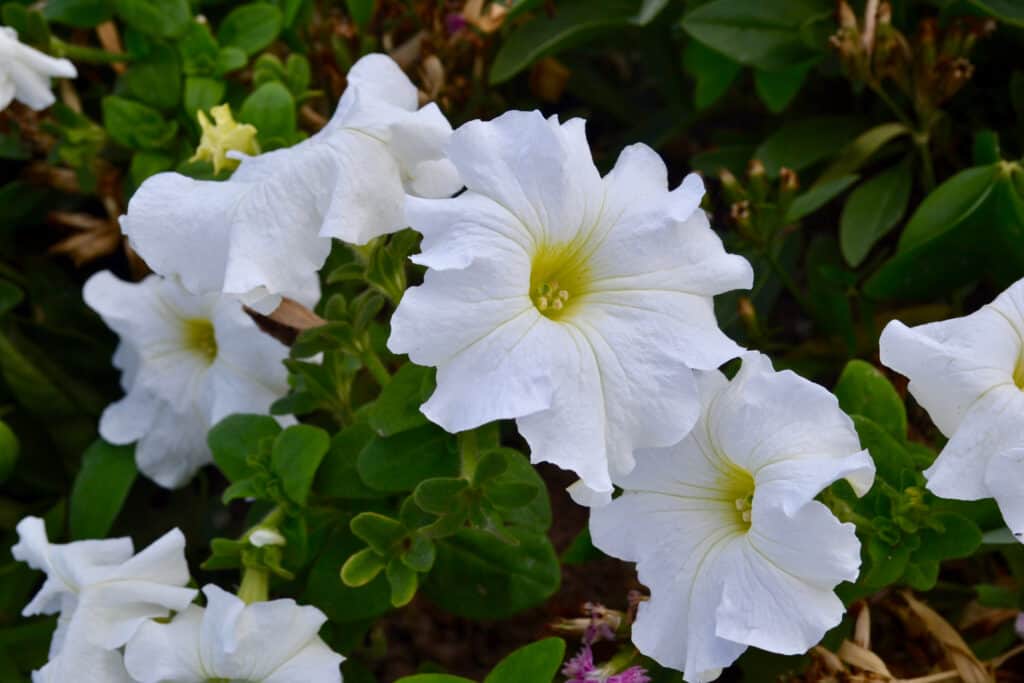
You’ll find the tropical, bright moonflowers blooming on cloudy days and moonlit nights all summer long.
©Khadijahanifa/Shutterstock.com
A perennial flowering vine that blooms summer after summer, the moonflower offers up vivid white, fragrant blooms in tropical conditions. The gorgeous bloomer originated in the tropical Americas and has spread across to other locations where they thrive in climates similar to those found in USDA Hardiness zones 10 to 12.
These flowers thrive in full sun, unfurling their glorious trumpet-shaped blooms and heart-shaped dark green leaves. They earn their name, though, by blooming only at night and on cloudy days, not during the bright daylight hours.
Moonflower vines grow quickly up to 20 feet long when properly cared for. Water the seeds heavily after planting to help them germinate. Ideally, soak the seeds first. Then, once the plant is established, one or two deep waterings every week should do the trick.
Avoid planting where pets and kids may find them and eat the plant as they are mildly toxic to both humans and animals.
Morning Glory (Ipomoea purpurea)

Morning glories come in many varieties and colors. The ‘True Blue’ variety here is, perhaps, one of the most vivid of summer vine flowers.
©Hemerocallis/Shutterstock.com
Perhaps one of the most well-known vine flowers in the United States, the morning glory maintains its popularity due to its incredible beauty. The fact that the plant grows quickly and easily, even when poorly cared for, certainly doesn’t hurt.
Morning glories come in many colors, including white, pink, yellow, blue, red, orange, and purple, among other variants. The perennial plant prefers warmer, tropical climates, but may thrive in any Hardiness Zone from 2 to 11. Just plant them in warm, full sun and let them grow!
The plant may hit heights of 6 to 10 feet in height and 3 to 6 feet in width, so give them plenty of room. And, if possible, bring them indoors in cooler months to keep them coming back year after year.
Butterflies, bees, hummingbirds, and other pollinators will visit your garden frequently when you’ve got these stunners growing, too.
Replant as necessary, if potted, every couple of years to keep their roots healthy and cared for. Make sure the soil is well-drained, and keep the plant trimmed back or it may take over the whole garden.
Beach Morning Glory (Ipomoea pes-caprae)
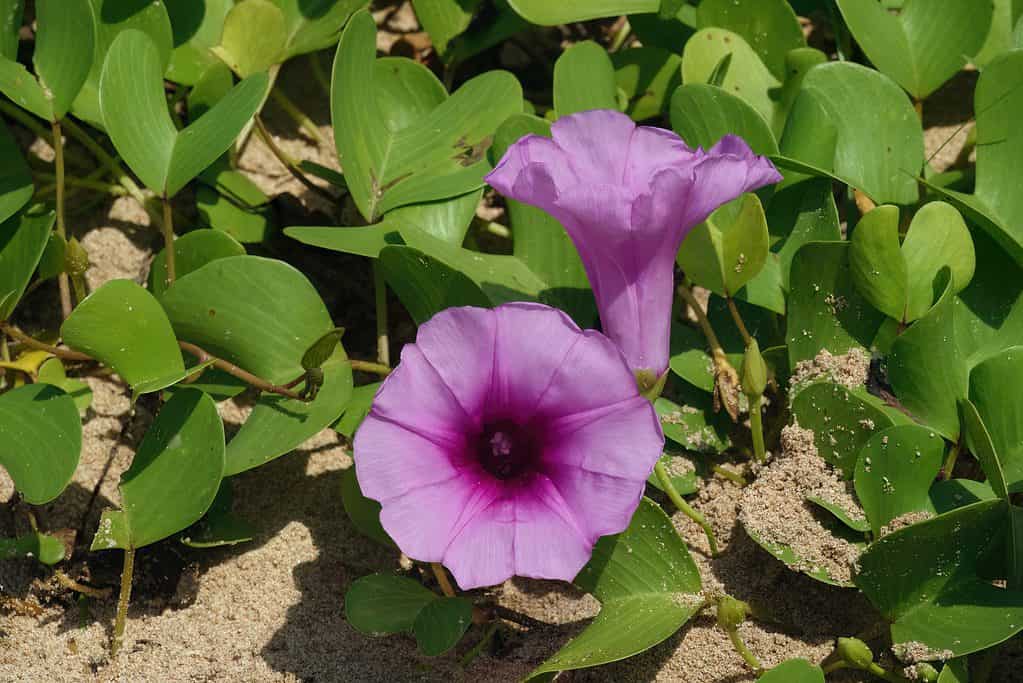
The purple blooms of the beach morning glory show up beautifully against the sand of coastal climates.
©MOrhon/Shutterstock.com
As the name implies, beach morning glories are a particular species of morning glory native to the coast. The stunning, colorful flowers creep along a vine and bloom all season long with upward-facing trumpet blooms. The delicate, tissue-like petals draw in all sorts of pollinators, with the vine itself growing up to 100 feet long.
The pale lavender-pink petals come with white stripes and the plants grow kidney-shaped leaves. These beauties love direct, full sun all season long, meaning they’re the perfect choice for those hard-to-plant spaces. They also thrive in sandy soil, so plant all you want in those coastal spots!
They also endure salty air and sea spray, as well as drought, meaning they’re a particularly versatile vine that helps fight soil erosion. Be sure to prune them back to encourage blooming. And plant carefully, as beach morning glories will overtake anything you plant them close to. The seeds may be toxic, as well, so keep them away from the kids and fur babies.
Black-Eyed Susan Vine (Thunbergia alata)

The black-eyed Susan vine offers simple beauty all summer long.
©Nahhana/Shutterstock.com
Thriving in full sun to partial shade, the Black-Eyed Susan vine is a gorgeous option for your summer garden. The vine blooms from summer to autumn, popping out bright orange, yellow, or white blooms with dark centers. Pick up a pack of seeds or grow them from nursery plants. Give them a trellis or plant in hanging baskets. The vine loves both growing options and so makes for one of the most versatile summer blooming vines around.
Provide these beauties with well-drained, moist soil, and they’ll thrive and reach up to 8 to 20 feet in length. In USDA Hardiness Zones 10 and 11, they’re perennials. Elsewhere, black-eyed Susan vines more likely will grow as annuals. If you’re planting them in a hot, dry locale, give them partial shade to avoid leaf scorch.
The plant self-seeds, so even if you’re living in cooler climates, you’ll have new plants each year. This also means they can be invasive, so keep them in check and only grow them where they won’t harm other plants.
Tangerine Beauty Crossvine (Bignonia capreolata)

The vividly colored Tangerine Beauty Crossvine adds a lot of unique beauty to any space all summer long.
©simona pavan/Shutterstock.com
A semi-evergreen perennial flowering vine, the Tangerine Beauty Crossvine had become popular among folks needing some cover for buildings. The self-seeding, self-clinging vine quickly overtakes pesky areas like ugly exterior walls or broken-down buildings. They cling to just about anything.
These beautiful bloomers thrive in full sun in USDA Hardiness Zones 6 to 9. They reach up to 30 feet in length, as well. They love full sun but also tolerate shade and poor soil, or soggy soil, making them as versatile as they are lovely. Give them water once weekly in average weather and three times weekly in extreme heat.
The trumpet-shaped blooms draw in loads of hummingbirds, butterflies, and bees, and offer shades of yellow, orange, and similar “sunset” colors. For best results, prune back the crossvine to prevent it from overtaking the entire garden. If you want to keep the plant highly contained, remove the root suckers.
Bougainvillea (Bougainvillea spp.)

Bougainvillea flowers come in many vivid, bold colors you’ll enjoy all summer.
©Martina Sappe/Shutterstock.com
With papery petals that almost seem like leaves, bougainvillea comes in a range of colors. Most commonly, you’ll spot vibrant fuchsia, red, orange, coral, cream yellow, white, purple, pale pink, or bi-color pink and white shades. The flowering vine thrives all summer long, displaying vividly colored blooms.
Tough conditions don’t bother these vines, either. Poor soil, intense direct sunlight, and even some drought won’t destroy these gorgeous vines. Different varieties come with or without thorns, so choose wisely to avoid potential problems for pets, kids, or gardening needs if you’re sensitive.
The one thing these plants can’t handle is cold weather – they don’t do well in cooler zones. Instead, plant these beauties in USDA Hardiness Zones 9 to 11. If you plant in cooler areas, be sure to provide them with solid winter protection.
Bougainvillea, named after French navigator and admiral Louis Antoine de Bougainville, originated in South America. They grow between 15 and 30 feet tall and 10 to 20 feet wide. 14 species and 250 varieties of bougainvillea exist, none of which need much in the way of care, once they’re established.
Periwinkle (Vinca minor)
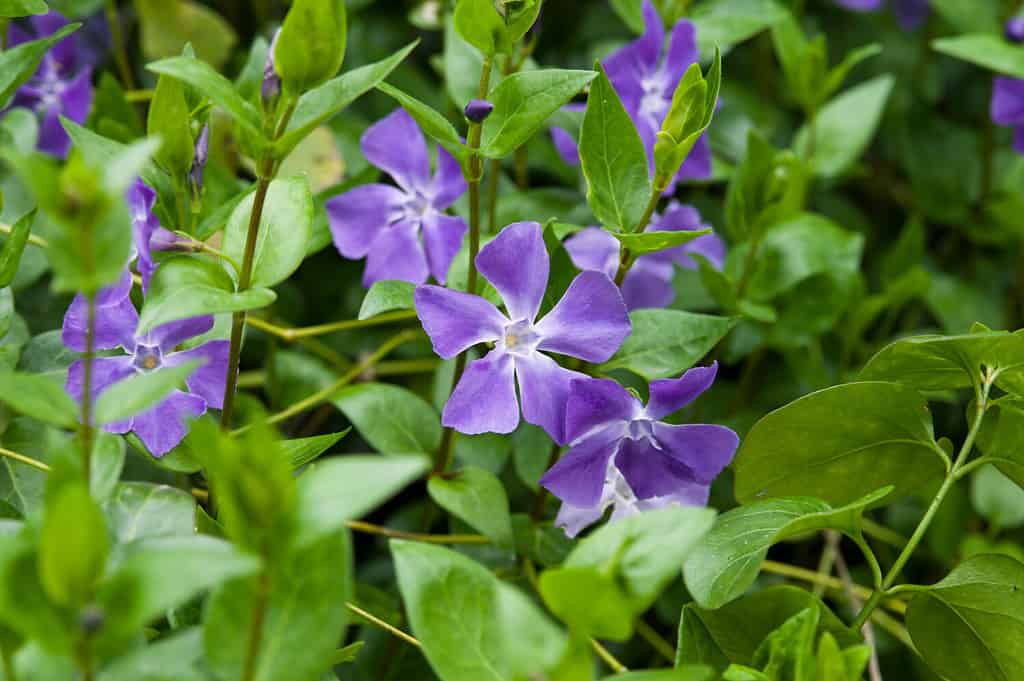
Periwinkle offers beautiful blooms as summer flowering vines.
©zzz555zzz/Shutterstock.com
Originating in Europe, Periwinkle thrives in USDA Hardiness Zones 4 to 9. The versatile vine flower easily trains to climb or spread, whichever is preferred. Periwinkles grow as evergreen perennials in a wide range of growing conditions. Full sun to partial shade needs, low-maintenance levels, and pest resistance all help make this vine particularly popular for new gardeners.
They reach between 3 and 6 feet tall, with trailing vines out to 18 inches long. Folks often plant this beautiful vine for ground covering, thanks to its creeping habit. You’ll see them bloom in blue, purple, white, or purple flowers. Depending on your Grow Zone, you’ll find the flowers pop out in late spring to summer and steadily bloom for quite some time.
Be aware that the plant is toxic to pets, so you’ll want to plant carefully.
Climbing Roses (Rosa)

Be sure to provide your climbing roses with plenty of support. The stunning summer flowering vines will thrive and keep up the beauty all season long when properly cared for.
©ToriNim/Shutterstock.com
Starting in spring, and going into autumn, climbing roses bloom all season long. These roses adapt easily to many locales and will train to grow on pillars, arbors, gazebos, fences, and more. The plants are technically mutations or varieties of standard rose bushes. Some bloom once during the season, while others continually, so be sure to check which type you’re planting.
Climbing roses thrive in full sun and moist well-drained soil, growing up to 10 feet tall. The plants will come back year after year when grown in USDA Hardiness Zones 5 to 9, while they’ll grow as annuals in Zones 4, 10, and 11.
To get the most out of your climbing roses, you should train them to climb on trellis and similar structures. This helps the plant produce more flowers. They’ll also grow best with consistent morning watering at the base. Avoid overwatering to prevent fungal diseases.
Honeysuckle (Lonicera spp.)
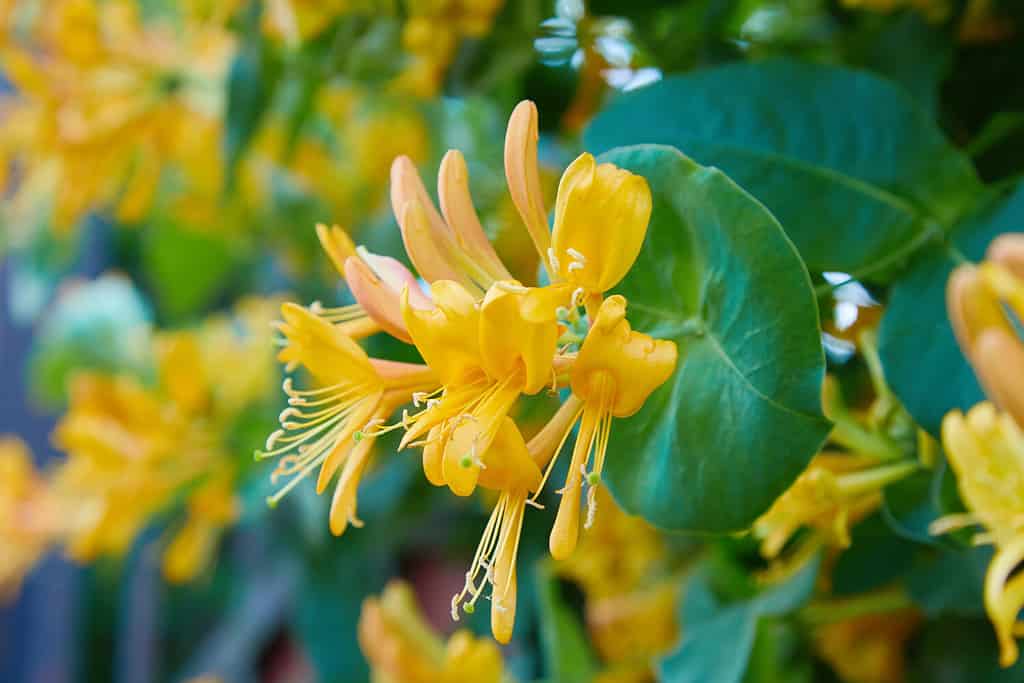
Bees, hummingbirds, and other pollinators adore the summer flowering vines of honeysuckle.
©krolya25/Shutterstock.com
Depending on where you live, your honeysuckle vines could bloom from early spring into autumn or nearly year-round. The sweetly fragrant flowering vines blossom with cream to yellow to orange trumpet-shaped flowers rich with nectar. Hummingbirds, bees, and other pollinators adore these plants. And most folks love the heady aroma as they pass them by.
Honeysuckle thrives as cascading vines over fences, lattices, and gazebos, but they do quickly overtake anything else nearby as well. So, plant these gorgeous vines carefully! The specific species determines how hardy the plants may grow, as well as which zones they thrive in. Most do best in USDA Hardiness Zones between 4 and 9. They love full sun but do well in light shade. Some grow as tall as 20 feet when planted properly in well-drained, medium-moisture soils.
Passionflower Vine (Passiflora incarnata)
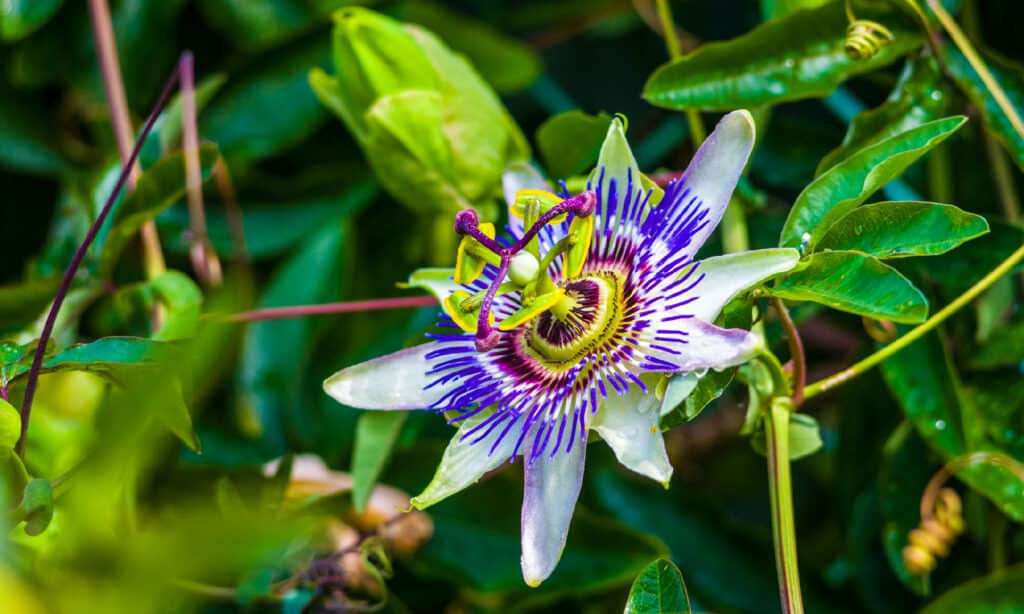
The exotic-looking passionflower offers its beauty all summer long.
©iStock.com/Shedu
Climbing up to 8 feet in height, these unique purple flowering vines are quite the sight, especially in the wild. Passionflowers are named for the unique structure of the plant. The stunning blooms look like something you’d expect in a distant, “exotic” land, but they grow wild in places like Tennessee. So, no matter how tropical they look, passionflower vines can grow in Illinois and other cool weather climates.
The ideal USDA Hardiness Zones for Passionflowers run between 6 and 11, allowing them to grow perennially. Outside these, passionflowers are more likely to grow as annuals. The plants show themselves in late spring and produce colorful blooms all summer long.
They do well in full sun to partial shade, grow up to 20 feet in length, and spread aggressively when not kept in check. Plant passionflowers in well-drained soil, near trellis or fence for best results.
Climbing Hydrangea (Hydrangea petiolaris)
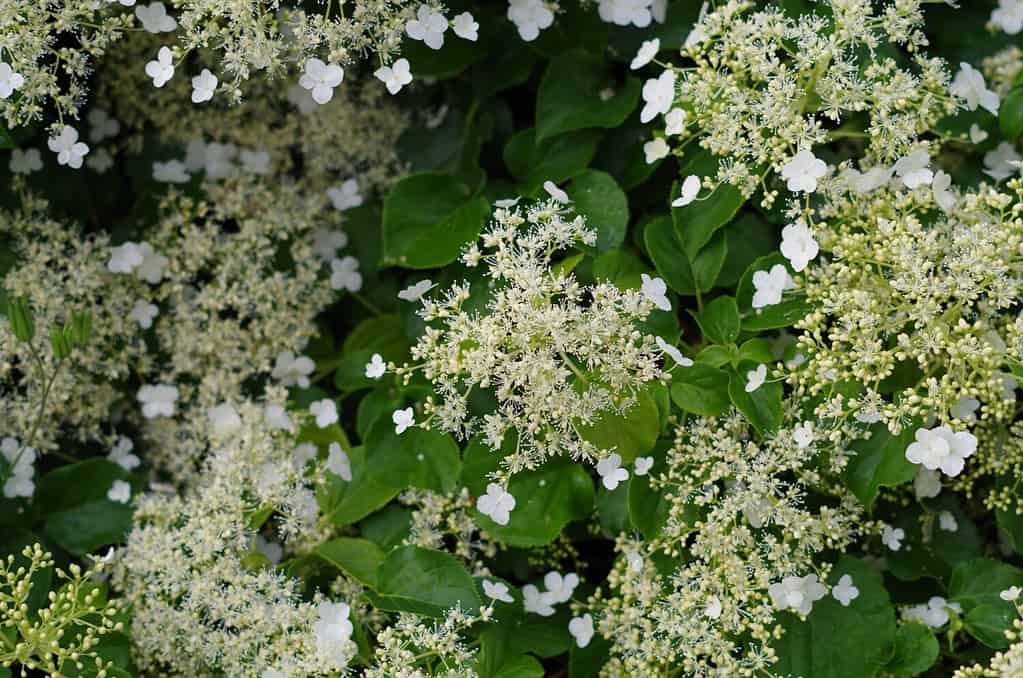
Climbing hydrangeas look a bit different from traditional hydrangeas, but they bloom as they climb.
©shadesofquartz/Shutterstock.com
Blooming from late spring into the summer and all season long, climbing hydrangea offers some elegant blooms you’ll love. The fluffy, white, flattened blooms pop out through vibrant foliage that may turn colors in autumn. The vines grow up to 50 feet in length and thrive in USDA Hardiness Zones 4 to 9.
Plant these beautiful plants in moist soil and provide them with strong structures for healthy growth and spread. These gorgeous vines are pretty chill, requiring limited care while thriving in full sun to partial shade. The one thing to note is that the plant is a bit slower growing than other types of hydrangeas. The climbing hydrangea offers a sweet fragrance.
If you notice the plant’s leaves curling or turning brown, you’re facing powdery mildew or fungal disease. Using some natural, homemade spray is your best bet for dealing with the issue.
Cup and Saucer Vine (Cobaea scandens)
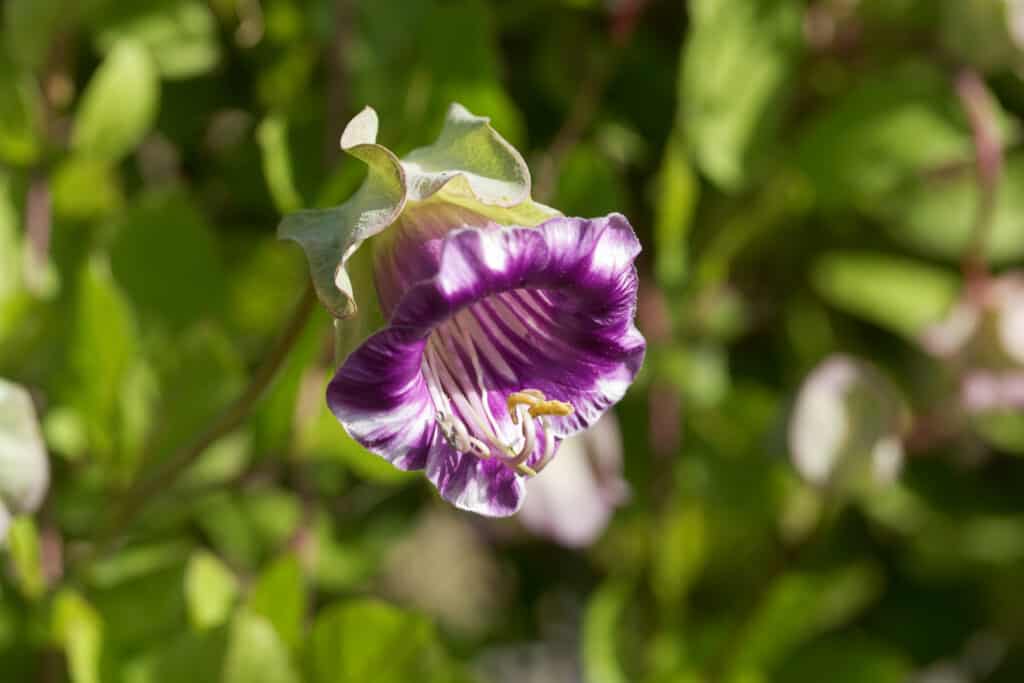
Cup and saucer vines provide bright color all summer.
©iStock.com/weisschr
Cup-shaped flowers and thin leaves dot the cup and saucer vine plant. The climbers grow between 3 and 6 feet wide and 10 to 20 feet long. The plant may be either perennial or annual, depending on your region and the care offered to the plant. The fragrant flowering vines love full sun and do best in USDA Hardiness Zones 9 to 11.
The flowers come in a range of colors, but most start out pale green and turn white or purple when they fully bloom. The fast-growing vine may be started from seed or nursery plants in the spring. As the plants mature, they’ll quickly spread and could overtake the rest of your garden. Be sure to plant them where they’ll have support and can be contained.
Clematis (Clematis alpina)

Make sure you provide your clematis with proper support and keep them trimmed, or else they’ll take over the whole garden.
©iStock.com/susandaniels
One of the most versatile summer flowering vines, clematis has become one of the most popular plants you’ll find. They start blooming in summer and the flowers may last into early autumn. You can also find varieties that bloom in spring or autumn instead, so plan carefully based on the variety you like best.
Clematis thrive in USDA Hardiness Zones 3 to 9, in full sun to partial shade. Keep them in well-draining soil and consistently moist. The plants, depending on variety, may grow as long as 25 feet. The plants come in many varieties, which means many hardiness levels, colors, and types.
Summary of 13 Flowering Vines That Bloom All Summer
| Flowering Vine | Grow Best in | Good to Know | |
|---|---|---|---|
| 1 | Moonflower | Full sun | Mildly toxic to both humans and animals |
| 2 | Morning Glory | Full sun | Prefers warmer, tropical climates |
| 3 | Beach Morning Glory | Full sun | Seeds may be toxic |
| 4 | Black-Eyed Susan Vine | Full sun to partial shade | Can be invasive |
| 5 | Tangerine Beauty Crossvine | Full sun but tolerate shade | They cling to just about anything |
| 6 | Bougainvillea | Best in zones 9 to 11 | Avoid cold weather |
| 7 | Periwinkle | Full sun to partial shade | Toxic to pets |
| 8 | Climbing Roses | Full sun | Grow best with consistent morning watering |
| 9 | Honeysuckle | Full sun but do well in light shade | Can spread aggressively |
| 10 | Passionflower Vine | Full sun to partial shade | Can spread aggressively |
| 11 | Climbing Hydrangea | Full sun to partial shade | Grows slower than other types of Hydrangeas |
| 12 | Cup and Saucer Vine | Full sun | They spread quickly |
| 13 | Clematis | full sun to partial shade | May grow as long as 25 feet |
The photo featured at the top of this post is © Hemerocallis/Shutterstock.com
Thank you for reading! Have some feedback for us? Contact the AZ Animals editorial team.






